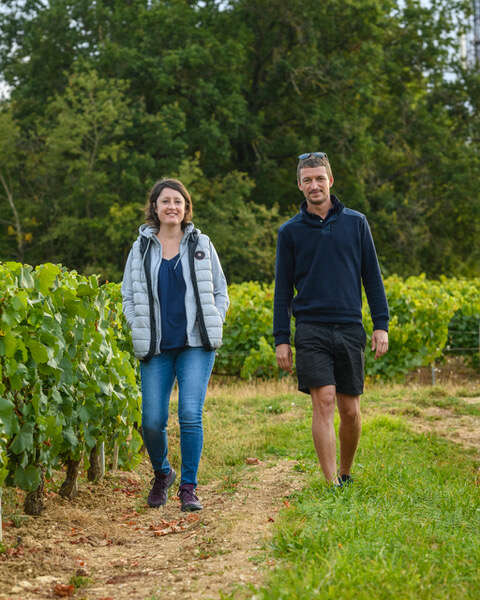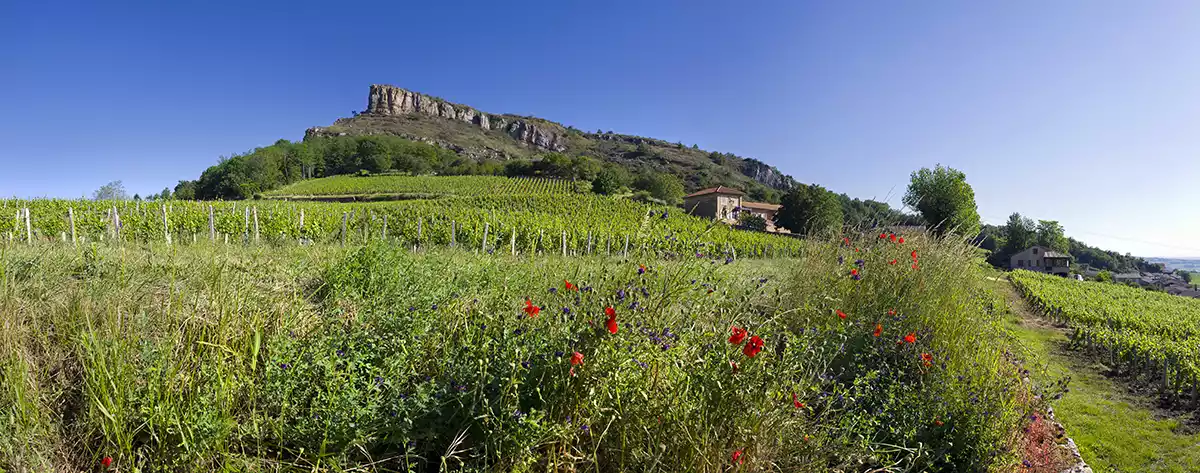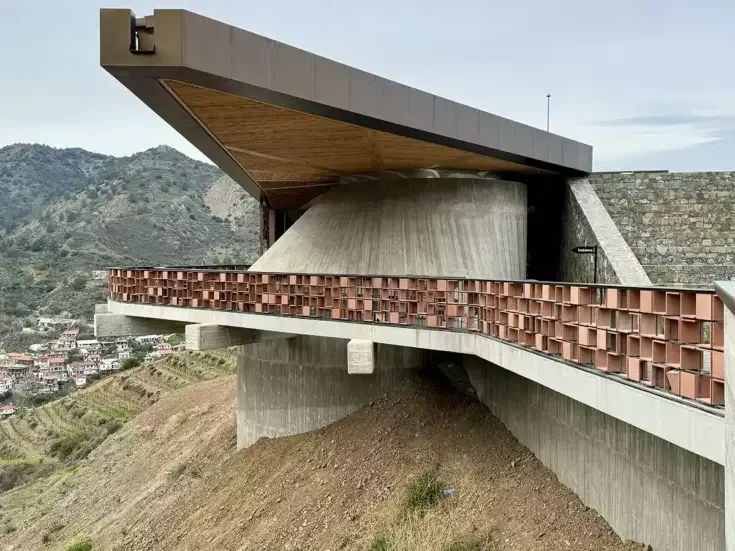
Sarah Marsh MW takes an uncoventional tour of three climats in the Chablis premier cru of Montmains in the company of Isabelle Raveneau—before enjoying a vertical tasting of Raveneau’s flagship cuvée, Montée de Tonnerre.
The scooter was a hefty bit of kit—large and alarmingly powerful. When Isabelle Raveneau suggested scooting around her Chablis vineyards I envisaged a motorised version of a kid’s scooter. During a practice run behind the domaine, the beast leapt forward at speed before I located the breaks. It was a shaky start, but Isabelle reassured me that Bernard Raveneau, who is over 70, had recently enjoyed a ride out. Bernard was clearly amused by our expedition, so there was no backing out. I buckled up my helmet and followed Isabelle towards the left-bank premier cru slope of Montmains where Domaine Raveneau has vines in all three climats—the eponymous Montmains, Butteaux, and Forêts.
First port of call was the Montmains section which lies on a very gentle east-facing slope. It is almost flat at the end nearest the town where it catches the evening sun and we were fortunate to have a glorious evening. “This often gets the wind and ripens later, but is the first of the three wines to be accessible,” explained Isabelle. “It is more aromatic, but less mineral than Forêts.”
Within the collective premier cru of the slope of Montmains, the climat of Montmains is the most exposed. It’s flatter and cooler than Forêts and Butteaux and I find them typically fruity with an earthy robust expression, although among them Raveneau’s is more refined.
We continued uphill past the top of Forêts towards Butteaux, picking up the pace as I was getting to grips with the scooter, which can reach 50 km an hour. Not that I was in any mind to go so fast.
We pulled up onto the bank as a large tractor hove into view with spraying apparatus like furled spider legs. It was Isabelle’s cousin, Maxime Raveneau. The cousins took over full responsibility for the 10ha (24 acres) domaine from their parents, Bernard and Jean-Marie, during Covid, with Maxime looking after the vineyards and accounts, and Isabelle the winemaking and sales. This mirrors the way their parents divided responsibilities. “I’m not interested in driving tractors,” says Isabelle. “It’s a boy thing.”
Maxime stopped to speak with Isabelle. There had been a problem with the tractor when he arrived to spray first thing in the morning, but returning to the vineyards after it was mended, he discovered the spray had settled in the tank and needed re-mixing. A long day with little accomplished and much to do. Rain was forecast and the vines needed protecting. The domaine is not organic, the family prefer to use one or two systemic sprays—just one in 2022—which they argue has the double advantage of fewer copper and sulfur sprays and less compaction of the soil.
Reaching the top of the Butteaux vineyard, we dismounted. The hill reaches its high point at the south end of the slope giving Butteaux the highest altitude and steepest incline, although not for all the vines as it drops down into the valley. It’s difficult to pin down a typical expression for Butteaux; it has the most sapidity and is often the most intense of the three climats. At some domaines, this sapid character is combined with a certain breadth and punch, but at others Butteaux is quite straight. It seems likely this is linked to the varied aspects within this climat. In this Butteaux differs from the more uniform east/south-east exposure of other sections. Moreover, everyone who makes Butteaux describes the soil differently, although there is generally a high proportion of white clay here. At Domaine Raveneau it’s the most mineral, but also the more dense and powerful of the three Montmains premier cru.
“Our parcel is at the top of the climat,’ says Isabelle. ”As the highest section this has the coolest micro-climate. There is more white clay here, which is sticky when it rains, but bakes hard when it’s dry. It doesn’t suffer though, as the vines are quite old here, about 55 years old.”
Raveneau is currently working with a group of ten domaines, including William Fèvre, Laroche, Vincent Dauvissat, and Long-Depaquit to develop a Chablis massal section. “It’s good to have bigger and smaller producers sharing this project as we all have old vines which we can put in a common pot to establish a diversity of genetic material from Chablis vineyards,” remarks Isabelle.
We wheeled the heavy scooters down the steep Butteaux slope between two rows of vines, passing occasional unplanted sections. “They form an erosion ‘wall’,” says Isabelle. “It’s important when it rains, but not everyone does it.” We continued along the valley floor into neighboring Forêts.
“Forêts has a lighter, more friable soil than the other parts of Montmains,” she explains. “At the bottom of the slope here the soil is deeper and we are in a bit of an amphitheater, so it’s warmer.” It was true. In this section there was no breeze and at 7.30 pm on June 16th it was still hot.
Despite the warm position of Raveneau’s parcel, Forêts has the lightest and most floral expression of Montmains although there are some riper lychee notes in a warm vintage such as 2022. It is typical of the floral and more light-footed feel of Forêts.
We had planned to tour the whole domaine, but given my lack of scooting skills, it was getting late, and we still had a short vertical of Montée de Tonnerre to taste so we hastened back to the domaine.
Raveneau have three hectares across ten parcels of Montée de Tonnerre, which represents a third of the domaine’s landholding. Half is located in Chapelot, the best place with its sunny exposure, and the other half in Pied d’Aloup. “Chapelot has southerly exposure, but it’s not a warm wine,” remarks Isabelle. “Montée de Tonnerre is our biggest cuvée, our flagship so we only make Chapelot separately in a very large vintage. The last time was in 2018. Montée de Tonnerre always produces a very sapid grippy wine.” However, as evident from the wine below, age can reveal its more graceful expression.
Tasting Raveneau Montée de Tonnerre
Raveneau Chablis, Premier Cru Montée de Tonnerre 2021
Restrained. Hint of pea shoot. Firm and tight. Gravelly grunt, tension, and vibrancy. Finishes salty. 2026-30+
Raveneau Chablis, Premier Cru Montée de Tonnerre 2020
Bearing some resemblance to ’22, this has richness and depth. Firm and punchy. Muscle and dense matter. Intense, fresh mineral finish. Lovely length. 2027-40
Raveneau Chablis, Premier Cru Montée de Tonnerre 2014
Super fresh and lively butter-mint aroma. Attacks the palate. Zesty, pure, and minty. It’s tight, vigorous, and vibrant. I like this concise and crystalline wine. Zips home on a racy and well sustained finish. Seriously good. Drink over the next ten years.
“This is still a baby. So fresh,” remarks Isabelle. “The nose is not very expressive. There is lots of potential and it shows how Montée de Tonnerre can evolve. Still a little austere. It will age 20 years without problem. I am sure in 10 days this bottle will still be crisp and fresh.” I bore this off to taste over the next few days during which it remained zesty and youthful developing slightly salted almond notes, while becoming more delicate and refined.
Raveneau Chablis, Premier Cru Montée de Tonnerre 2007
A bouquet of freshly mown hay and flowers. It was a cold vintage and yet the expression now is so honeyed with sweet hazelnut notes and still some citrus fruit. Silky and elegant. Cool and pure. A fine steely core carries to an energetic finish. Gorgeous now. “Honeyed with a waxy note, and very delicate mushroom. Nutty. Not so strong. So shiny,” says Isabelle.
Raveneau Chablis, Premier Cru Montée de Tonnerre 1996
Rich hazelnut and lightly buttered toast on the nose, while the palate is super fresh, vibrant and saline. After a grippy attack it cuts a slice across the palate and whips on a salty line. Still quite severe—whiplash Chablis. I can’t see further bottle age adding anything more to this wine, so I would decant and drink.
“The acid in the ’96 is very there! From the smell you expect it to be round and rich, but the palate is sharp and Chablis. When it was young it was undrinkable and now most of it is gone!” says Isabelle.






